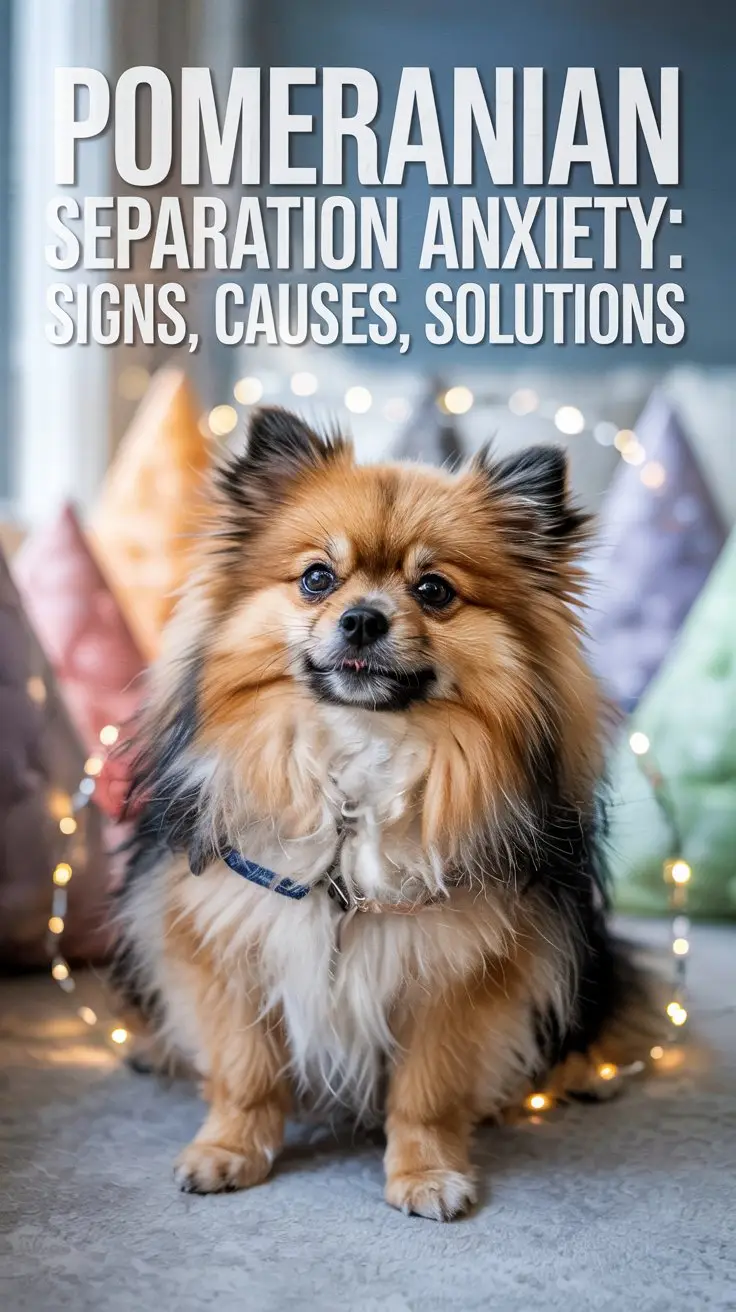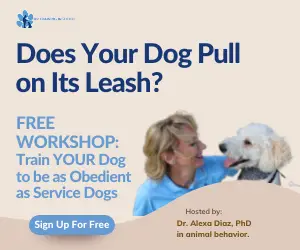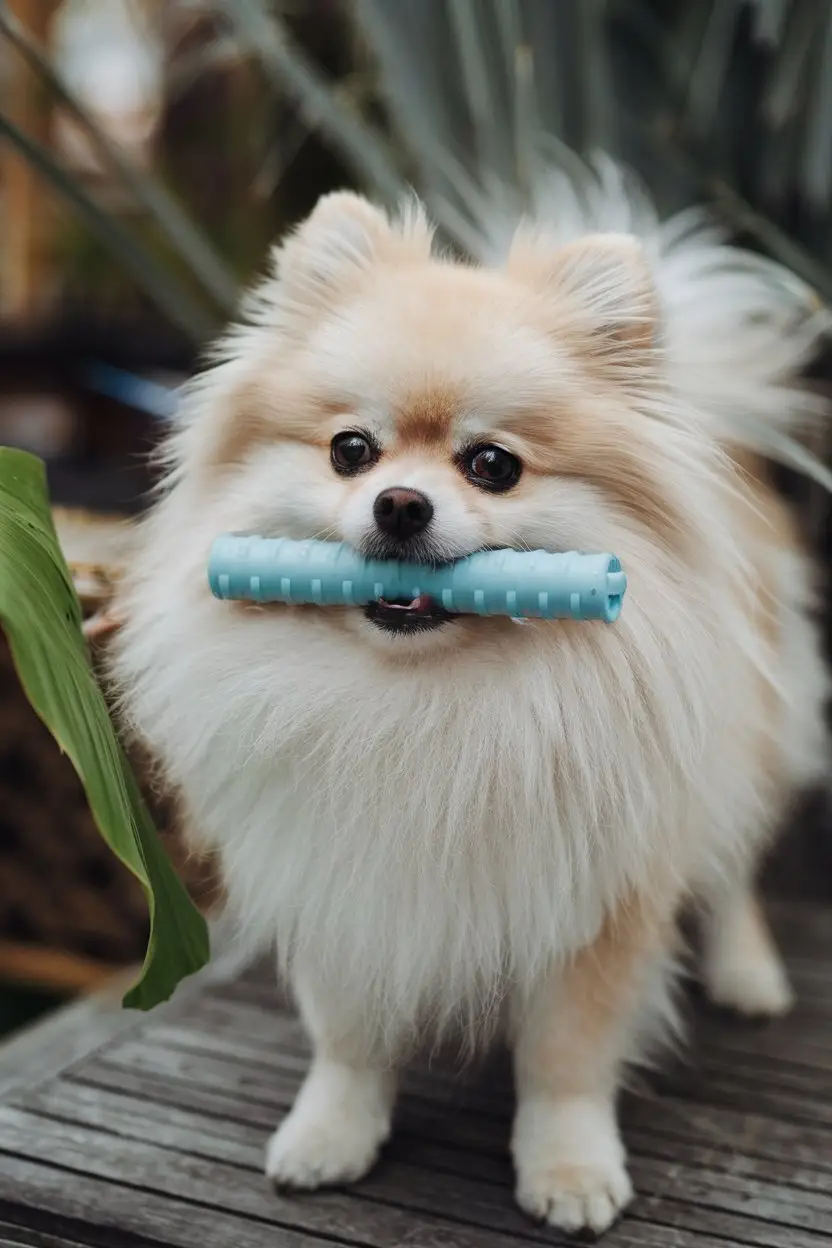Hey, if your little Pom is freaking out with non-stop barking, tearing stuff up, or having potty accidents when you’re gone – take a breath!
😰 Separation anxiety isn’t just annoying barking—it can be deadly serious
👉 See which pet insurance plans cover both injury AND behavioral treatment because most only cover the physical injuries, not the underlying cause.
You’re definitely not the only one dealing with this. Around 40% of Poms get super anxious when their humans leave, whether it’s from rough experiences in their past, not enough training, or just being super attached to you.
First things first – pop by the vet to make sure there’s nothing medical going on.
Then you can try some tricks that really work, like slowly getting them used to alone time, setting up their own cozy corner, and sticking to daily routines they can count on.
Remember to keep things positive and skip the scolding – it’ll only make things worse!
With the right mix of training, tweaks to their environment, and maybe some help from a pro, your furry friend can totally get through this rough patch.
Understanding Separation Anxiety

Hey, if you’ve ever left your Pom at home, you might have seen them freaking out a bit – that’s separation anxiety for you. It happens when your little furry friend gets super stressed out when you or family members aren’t around. And it’s not just them being dramatic – it’s actually a real mental thing that shows up in how they act and feel.
The thing is, some Poms might just get a little sad and whine for a few minutes when you leave, while others go full-on panic mode and start tearing stuff up. It’s kind of like a scale of how worried they get. The sooner you spot these signs, the better – because you can jump in and help before things get out of hand. If you notice your Pom acting weird or getting antsy when you’re grabbing your keys or putting on your coat, that’s your cue to step in and do something about it. Negative reinforcement tactics like scolding or punishment can actually make their anxiety much worse, so it’s important to stay patient and understanding.
Common Signs and Symptoms
Signs that your Pom has separation anxiety are pretty easy to see. Your pup might bark or howl like crazy when you’re not around, and they could start tearing up your stuff – you know, chewing on furniture or scratching at doors. Even if your dog knows better, they might start having bathroom accidents inside.
When it comes to physical signs, you might catch your dog drooling a lot, walking back and forth, or just being super fidgety when they sense you’re about to head out. Some Poms get so worked up they don’t want to eat, try to break out of the house, or start grooming themselves way too much. And don’t be surprised if your little buddy turns into your shadow, following you everywhere and getting super upset when they see you grabbing your keys or putting on your shoes. If you don’t deal with these problems, they usually get worse over time, so it’s best to tackle them as soon as you notice them. Crate training can help create a secure safe space for your Pomeranian when you’re away and reduce anxiety-related behaviors.
Root Causes
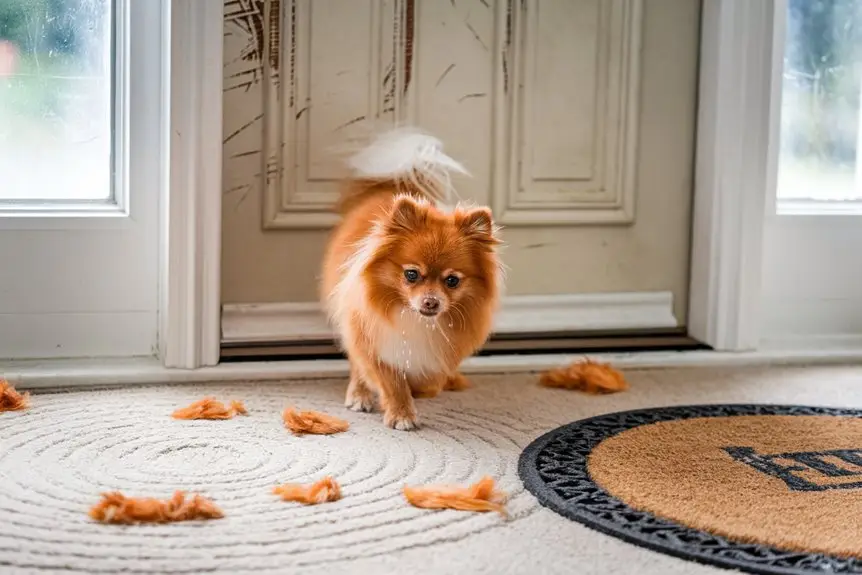
Let’s talk about why Poms end up with separation anxiety. Your little fluffball might get anxious for a bunch of reasons – maybe something scary happened to them, their daily life suddenly changed, or they didn’t get the right training as puppies.
Things that can set them off include moving houses, when you switch up your work hours, or if someone in the family passes away. If you got your Pom from a shelter, they might be carrying some emotional stuff from being left behind or treated badly before. Getting the whole crate thing wrong or keeping them locked up too much can also make them more anxious.
And here’s the thing – Poms are total love bugs who get super attached to their humans. This makes them more likely to freak out when you leave, especially if you didn’t teach them it’s okay to be on their own when they were younger.
These anxious behaviors can worsen if your Pom develops hypothyroidism and lethargy, making them even more dependent on your presence.
Training Methods That Work
Training a scared Pom who hates being alone isn’t easy, but you can totally fix it with some simple tricks. First, help them get used to stuff that usually freaks them out – like when you grab your keys or put your shoes on. Just do these things randomly during the day without going anywhere, so they stop getting worked up about it.
Start super small – like leaving for just a couple minutes, then slowly make it longer. Give them special goodies or fun toys they only get when you’re gone, so they start thinking “hey, being alone isn’t so bad!” Don’t go crazy with goodbyes or hellos – keep it chill.
Get them comfy in a crate or their own special spot where they feel safe, and give them some brain-busy toys to play with. Oh, and make sure they get plenty of exercise before you head out – a tired Pom is usually a calmer Pom! Choose a wire crate with partition that allows your Pom to stand, turn around, and lie down comfortably while feeling secure.
Creating a Safe Space
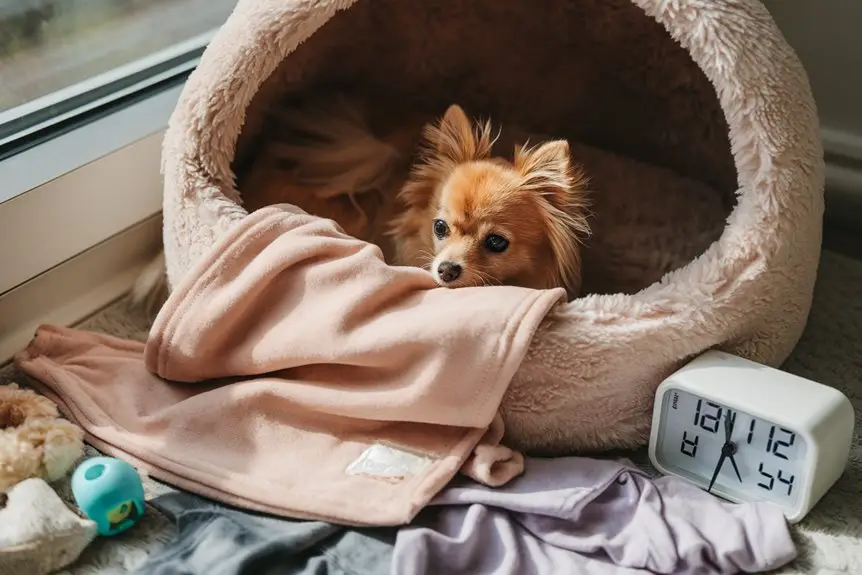
A cozy, safe spot for your Pom is super important when dealing with their separation anxiety. Pick a quiet corner in your home where your little buddy can chill out when they’re feeling stressed. Just toss in their favorite bed, toys, and a water bowl – it should feel like their own personal hangout spot.
Adding some stuff that reminds them of you can really help calm their nerves, like one of your worn t-shirts or a white noise machine to block out scary sounds. You might want to try some calming goodies too, like those plug-in pheromone diffusers or some relaxing tunes. Make sure they can easily get in and out, but keep it safe and free from anything that could hurt them. If you’re going with a crate, just check that it’s the right size and filled with comfy stuff. This special spot will be your Pom’s go-to place when you’re gone, helping them feel safe and more relaxed.
Child-proof gates can help restrict access to certain areas while still allowing your Pom to move freely within their safe space.
Mental Stimulation Activities
Your Pom has a super active brain and loves to play, so they need lots of fun stuff to do when you’re not around – it helps with their separation anxiety too! Grab some puzzle toys, balls that drop treats, and games that’ll keep them busy and entertained. This way, they won’t get bored or stressed while hanging out by themselves.
Mix things up by switching their toys every day to keep them interested. Try stuffing a Kong with frozen goodies, hiding treats for them to find, or getting a snuffle mat so they can follow their natural sniffing instincts. Those clever toys that give out kibble when your Pom solves the puzzle work really well too. Just make sure you show them how everything works while you’re there watching – that way they’ll know what to do when they’re on their own with their toys. Window watching activities can provide additional mental stimulation by allowing your Pom to safely observe the outside world.
Managing Alone Time
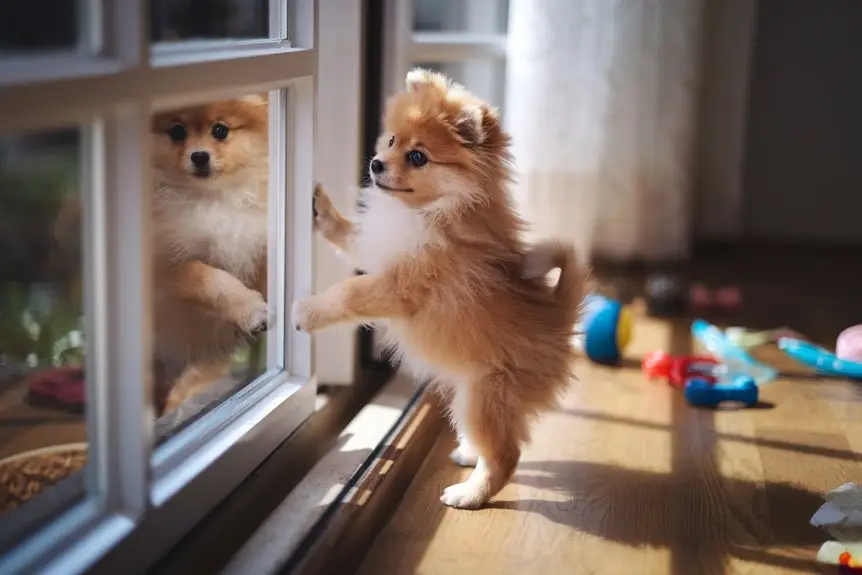
Being alone is tough on a Pom at first, so try to keep solo time super short when you start dealing with their separation worries. See if you can get a friend, relative, or someone nearby to hang out with your pup when you’re not home. As your furry friend gets better at handling time alone, you can slowly start leaving them by themselves more.
Keep it super simple – just step out for a tiny bit at first, like a few minutes tops. Then bit by bit, stretch out how long you’re gone as your pup gets more comfortable. Don’t try to rush things – taking it slow and staying consistent is the key to success. Before you head out, make sure your Pom’s gotten plenty of exercise and mental games to tire them out. If you need to be gone for longer stretches, maybe look into doggy daycare or having someone pop in for walks to break up the day. Setting up a camera can help you check how they’re doing and tweak your game plan if needed. Consider using calming pheromones like Adaptil to help reduce your Pom’s anxiety during alone time.
Professional Help Options
Getting help from experts can be a game-changer if your Pom’s separation anxiety is too tough to handle alone. Your first stop should be your vet – they can check out what’s going on and maybe even give your pup some anxiety meds if things are really rough. A dog behavior expert can whip up a training plan just for your Pom, focusing on what sets them off and how they act when stressed.
You can also team up with trainers who know all about separation anxiety. They’ll show you how to help your Pom get used to being alone and fix any behavior problems that pop up. Plus, they can help you set up daily routines that actually work. If you need extra backup, think about getting a dog walker or pet sitter – having someone around to play with and walk your Pom while you’re gone can really help take the edge off their stress.
Medication and Treatment Approaches
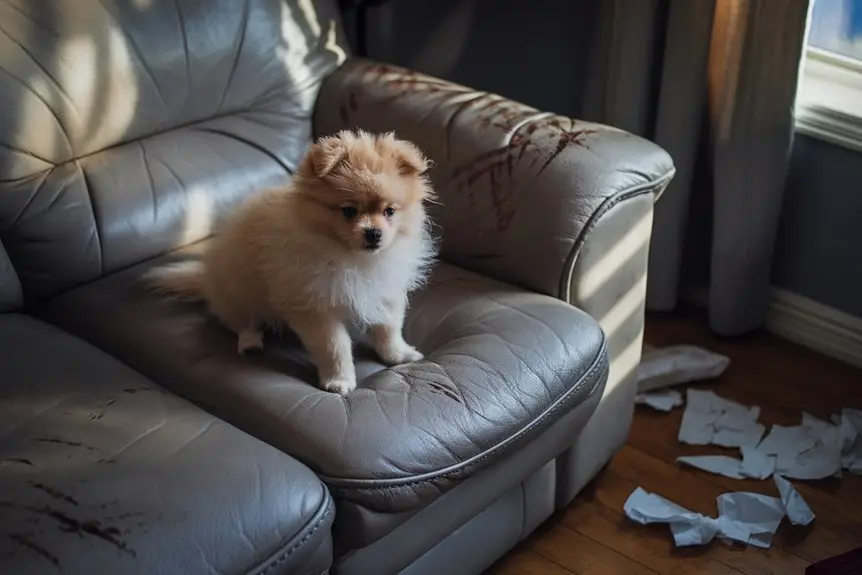
Treatment options for your Pom’s separation anxiety can be pretty simple or more involved, depending on how bad things are. If it’s not too severe, you can try basic stuff like rewards-based training, slowly getting them used to being alone, and keeping them busy with fun toys and calming products. When these don’t do the trick, your vet might suggest some anxiety meds to help your pup feel better while you work on changing their behavior.
Your vet might put your dog on medications like SSRIs or tricyclic antidepressants to help them chill out when you’re gone. You’ll need to keep an eye on how your dog does with the meds and stay in touch with your vet about tweaking the amounts. Just remember – meds aren’t a magic fix on their own. They work way better when you pair them with regular training and make changes around the house to help your pup feel more comfortable.
Prevention Strategies
Managing separation anxiety works way better when you get ahead of the problem instead of waiting for your Pom to freak out. Just start with a regular daily schedule that gets your pup moving and thinking before you head out. Try leaving for tiny bits of time at first, then slowly make those times longer while keeping an eye on how your furry friend handles it.
Make your place super cozy with safe spots, some background noise (like TV or music), and fun toys to keep them busy. Don’t go overboard with goodbye hugs or “I’m home!” celebrations – it only makes them more nervous. If you’re thinking about crate training, do it right from day one and make it feel like their happy place, not a time-out corner. For new Pom parents, ease into the alone time thing and give lots of treats for good behavior. Getting them used to other dogs, people, and places early on (plus some basic training) will help your little buddy feel more confident when flying solo.
Frequently Asked Questions
Can Separation Anxiety in Pomeranians Be Inherited From Their Parents?
Hey, did you know your Pom’s separation anxiety might run in the family? While they don’t exactly get it straight from mom and dad, they can pick up those nervous traits from their parents, which means they might be more likely to get stressed out when left alone. It’s kind of like how some people are naturally more worriers than others!
At What Age Do Pomeranians Typically Start Showing Separation Anxiety?
Your Pom will usually start getting anxious when left alone around 6-12 months old. But honestly, they can get separation anxiety at any age – particularly if something big happens in their life or if they go through something scary at home.
Do Female Pomeranians Experience More Severe Separation Anxiety Than Males?
You’ll notice that both boy and girl Poms can get super anxious when left alone – it’s not really about whether they’re male or female at all. What matters most is your pup’s unique personality and character. So if you’ve heard that girl Poms get more stressed out when alone, that’s not backed up by any real proof!
How Does Spaying or Neutering Affect a Pomeranian’s Separation Anxiety?
It’s like dialing back the stress levels – when you fix your Pom, they tend to mellow out a bit. Your little buddy might not freak out as much, but just know that the surgery isn’t a magic fix for any separation issues they already have.
Can Moving to a New Home Trigger Permanent Separation Anxiety?
Moving to a new place can really mess with your pet’s head and make them super clingy, but don’t worry – it won’t last forever! Just hang in there and keep working with your furry friend. Most dogs bounce back from the stress of switching homes if you give them lots of love and stick to a good training routine. They just need some time and help to get used to their new digs.

